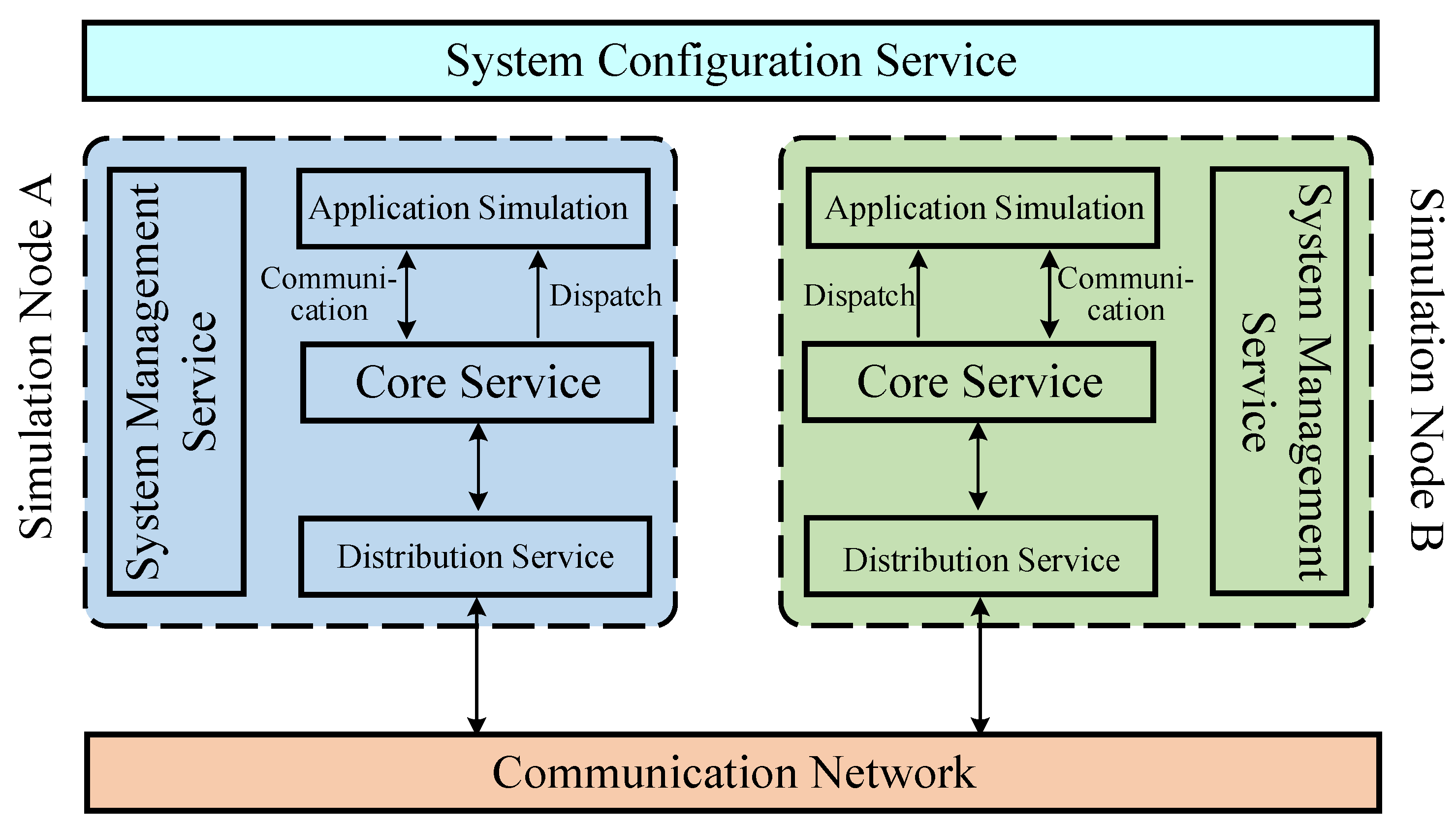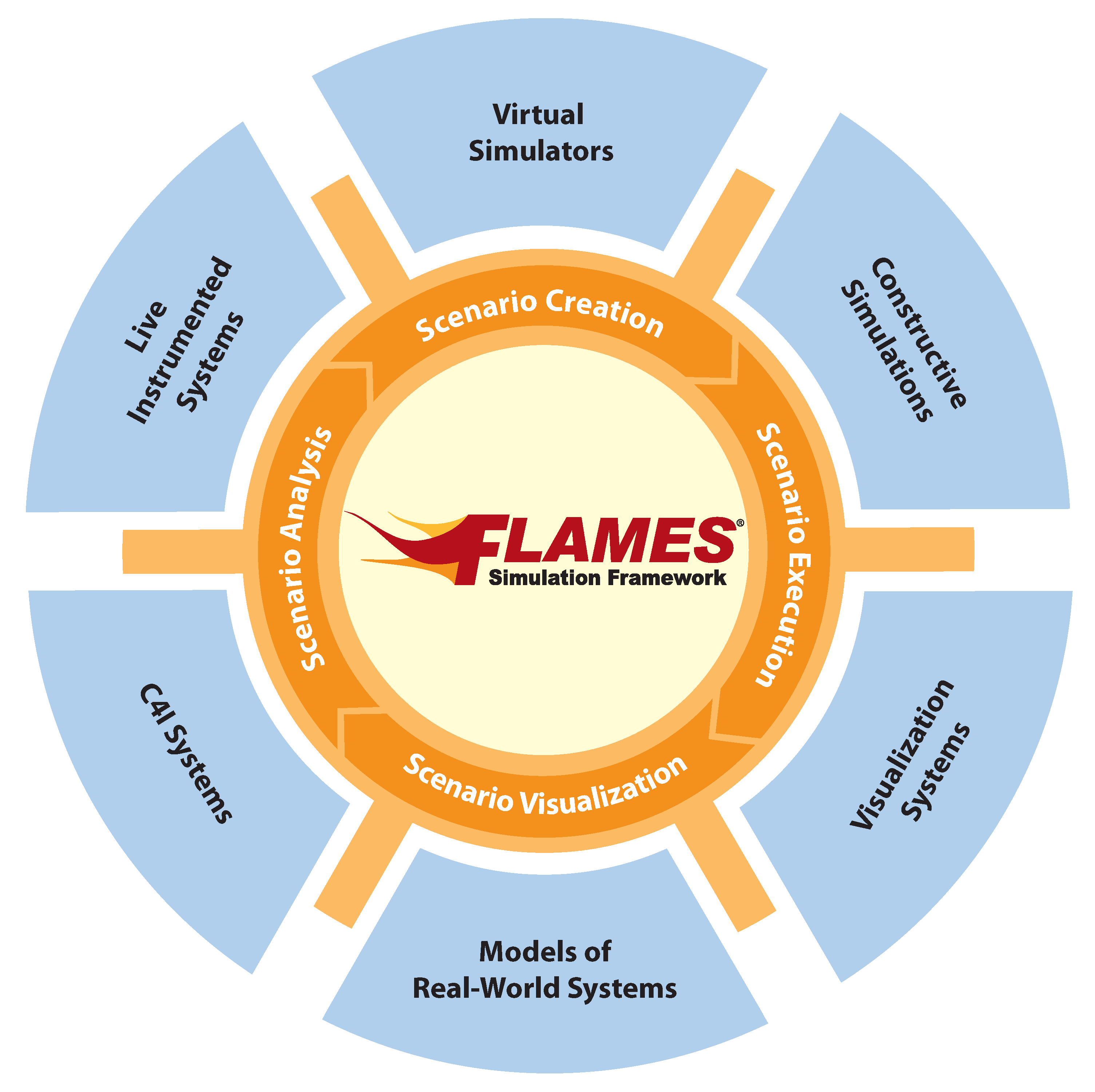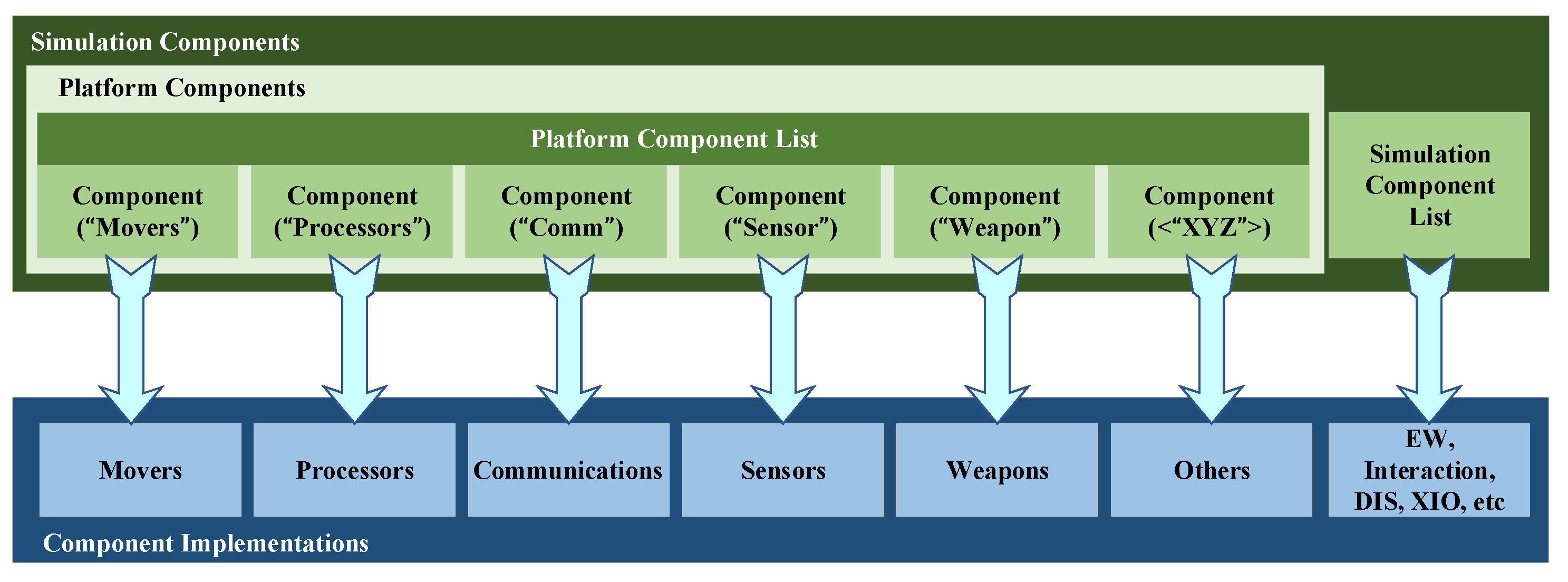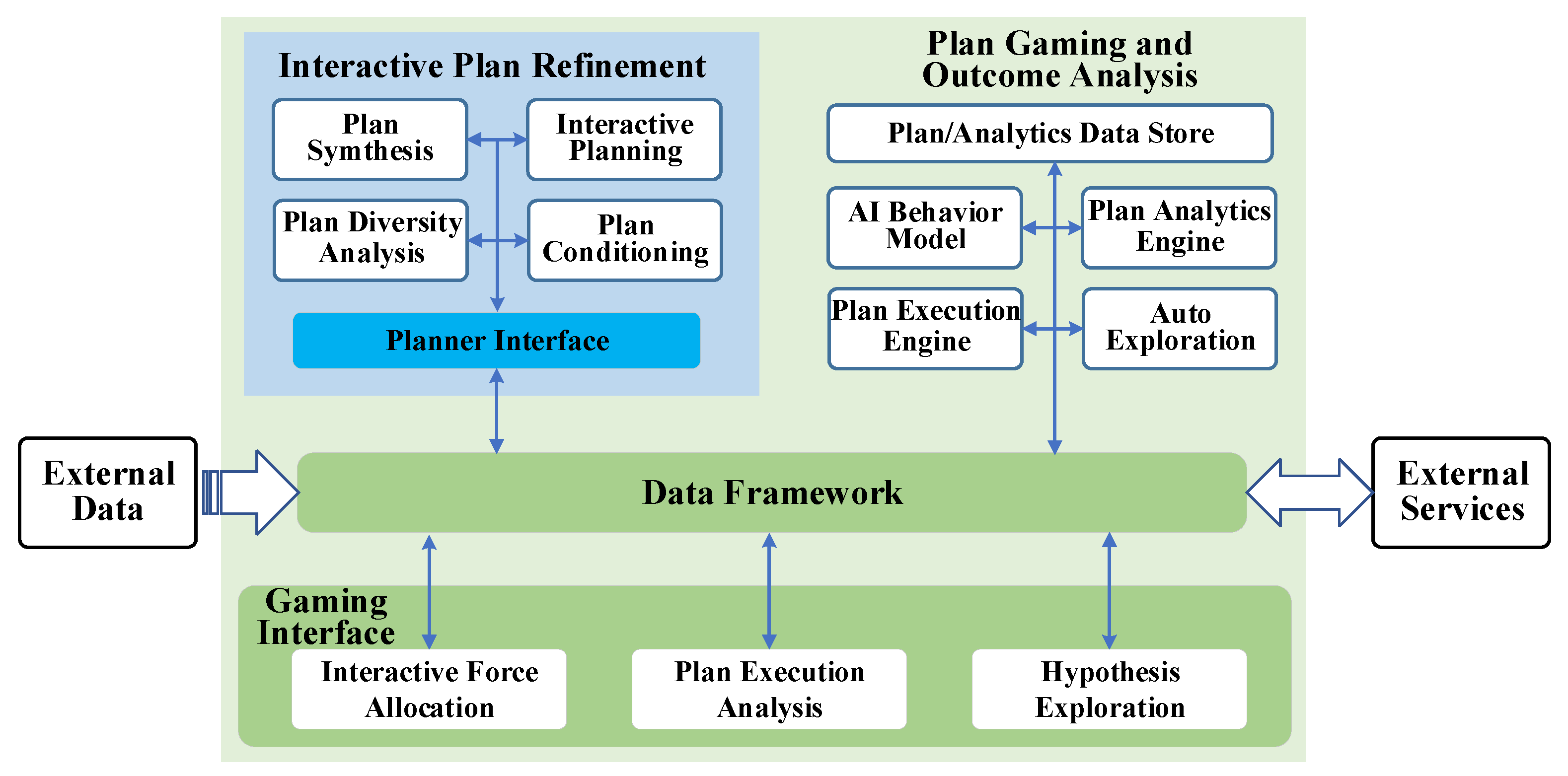Review of the Research Progress in Combat Simulation Software
Abstract
:1. Introduction
1.1. Literature Review Methodology
1.2. Manuscript Structure
2. Top-Level Specification of Simulation Software
2.1. SMP
- The system layer does not contain any abstract content and only describes the system objects in the real world to be simulated. In terms of abstract system elements, the system engineer can define that an aircraft carrier is composed of power, command and control, communication, and other subsystems according to the existing knowledge system, while in terms of specific system elements, China’s existing aircraft carriers include three warships named Liaoning, Shandong, and Fujian.
- The simulation layer mainly describes the platform-independent model of the simulation system, focusing on the model specification (catalog file) and the integration, configuration, and scheduling of the model instances. Concretely speaking, Figure 1 defines the basic model specification of an aircraft carrier, and the Fujian aircraft carrier represents a derived specific model specification, which adds the interface of the ejection system model.
- The software layer describes the platform-related parts of the simulation system. SMP2 provides a convenient tool to generate a large number of C++ codes from the catalog file and finally presents various simulation models in the form of libraries.
2.2. DIS
- The system configuration service configures the the operation environment for the whole system in an offline manner, such as the initial state of each simulation entity and geographic information.
- The system management service is responsible for the start, monitoring, termination, and other management work of the whole simulation process.
- The core service is responsible for the scheduling and communication of simulation tasks on the simulation node.
- The distribution service is responsible for the distributed communication and time synchronization within each simulation node.
- The application simulation is composed of a variety of application tasks, which are realized with the cooperation of the core service and distribution service.
- The interoperability between distributed simulation systems can only be realized by standardizing the data communication rules, and systems with complex logical hierarchical relationships cannot be processed.
- The information exchange between simulation entities is realized by broadcasting, and the utilization rate of bandwidth is very low.
- Lack of time synchronization between simulators may lead to spatiotemporal inconsistency.
2.3. HLA
2.4. LVC
- The application layer includes two types of simulation applications: the legacy applications based on existing simulation standards (e.g., DIS, TENA [23], and HLA), and new simulation applications based on DDS and other new architectures.
- The coupler layer provides various couplers between the application layer and the middleware layer, including interfaces, gateways, and services. The legacy simulation systems can be seamlessly connected to the middleware through the specific interface (e.g., DIS-DDS, TENA-DDS, and HLA-DDS), gateway, and various simulation services. New simulation systems, such as the ones based on DDS, can connect to the middleware layer with public interfaces and gateways.
- The middleware layer is the key infrastructure layer for data exchange, through which each simulation system can realize mutual operation. The LSA currently selects the data-centric DDS as the middleware to build a low-latency, high-reliability, and scalable communication architecture for the distributed simulation system.
- The protocol layer currently utilizes the interactive real-time publish–subscribe protocol DDSI [24] as the underlying communication protocol for the DDS middleware.
3. Simulation Engine and Simulation Framework
3.1. Simulation Engine
3.2. Simulation Framework
3.2.1. FLAMES
3.2.2. XSim Studio
3.2.3. AFSIM
3.2.4. E-CARGO
- The first-class components in E-CARGO are classes, objects, groups, agents, environments, and roles. They are the fundamental structures and depict the constructions or compositions of a complex system.
- The second-class components include messages, the initial state, and human users, which reveal the complexity of systems. For instance, messages reflect the numerous ways for the components to communicate, interact, coordinate, and cooperate.
3.2.5. Comparison and Analysis
- AFSIM and FLAMES have a very good distributed ability.
- Software modularization has become an important design principle in software engineering, and all four frameworks have good modularity.
- AFSIM and E-CARGO perform relatively better than the other two frameworks.
- E-CARGO outperforms the others in generality, since it can simulate complex problems in collaboration and complex systems.
4. Typical Combat Simulation Software
4.1. EADSim
- (1)
- Simulation setup. With the help of a graphical interface, the users can set the basic parameters, check the parameter consistency and boundary, and generate operational scenarios.
- (2)
- Run-time model. In the C3I decision-making process, the C3I model deals with an entity’s command and decision making; the flight processing model is responsible for updating the movement status of battlefield entities; the detection model simulates the working condition of the sensor; and the propagation model undertakes the simulation of network connectivity. In terms of system models, EADSIM supports operations such as air defense, air-to-ground, air warfare, electronic warfare, and cyber warfare and can model weapons, sensors, and a battlefield environment.
- (3)
- Post-simulation analysis. This module carries out statistical analysis on the simulation data, can realize the visualization of the combat simulation process, and can automatically generate reports such as engagement statistics, communication statistics, detection statistics, etc.
4.2. JTLS-GO
- (1)
- Force control. This includes command authority, relations between all parties, and engagement rules. The force commander can assign operations to the subordinates involved in the combat simulation. The participants need to determine the relationship between each other. Each combat unit has a specific set of engagement rules for different adversaries.
- (2)
- Ground operations. The commander can set engagement rules, establish a new ground maneuver route, and issue commands such as attack, defense, and fire support.
- (3)
- Air operations. There are three ways to implement air operations, namely automatic air mission command generator, manual input of instructions, and the combination of the two methods. The air mission command generator can create task packages composed of different types of aircrafts.
- (4)
- Marine operations. This can simulate ship-to-ship missile attacks, naval gunfire, amphibious attacks, regional patrol and anti-submarine warfare, air operations based on aircraft carriers, etc.
- (5)
- Logistics support. This includes automatic resupply, integrated supply, emergency supply, supply transportation, force transportation, etc.
- (6)
- C3I. The information obtained by any combat unit can be used by the whole force, so that the commander can master the enemy situation and make a thorough and timely plan.
4.3. Fight Tonight
- (1)
- Interactive plan refinement. This function generates plans through resource allocation and task priority setting, which can help users design force allocation schemes, understand the available schemes, and evaluate the impact of priority adjustment. The system generates a plan prototype according to the guidelines provided by users; then, users employ the automatic analysis function to evaluate other alternatives of the plan. At the same time, the system continues to optimize the alternatives and improve the accuracy of the plan through calculation.
- (2)
- Plan gaming and result analysis. The deduction platform will provide in-depth insights and experience for operational planning, which enables planners to analyze the expected performance and update the operational plan according to the simulation results.
5. Development Trends of Combat Simulation Software
5.1. Combat Simulation Software Should Be More Intelligent
5.2. Combat Simulation Software Should Be More Suitable for LVC Systematization
5.3. Combat Simulation Software Will Provide a Much More User-Friendly Experience
6. Conclusions
Author Contributions
Funding
Institutional Review Board Statement
Informed Consent Statement
Data Availability Statement
Conflicts of Interest
References
- US Operations Research Office. Software: Carmonette. 1953. Available online: https://handwiki.org/wiki/Software:Carmonette (accessed on 25 April 2023).
- Kessler, A. Russian Hypersonic Glide Vehicles: What to Know and What to Fear. Orbis 2022, 66, 213–223. [Google Scholar] [CrossRef]
- Laghari, A.A.; Jumani, A.K.; Laghari, R.A.; Nawaz, H. Unmanned aerial vehicles: A review. Cogn. Robot. 2023, 3, 8–22. [Google Scholar] [CrossRef]
- Snyder, H. Literature review as a research methodology: An overview and guidelines Hannah Snyder. J. Bus. Res. 2019, 104, 333–339. [Google Scholar] [CrossRef]
- Clive, P.D.; Johnson, J.A.; Moss, M.J.; Zeh, J.M.; Birkmire, B.M.; Hodson, D.D. Advanced Framework for Simulation, Integration and Modeling (AFSIM). In Proceedings of the 13th International Conference on Scientific Computing, Las Vegas, NV, USA, 27–30 July 2015; IEEE: Las Vegas, NV, USA, 2015. [Google Scholar]
- Ternion Corporation. FLAMES Simulation Framework. 2023. Available online: https://flamesframework.com/ (accessed on 10 January 2023).
- Zhu, H.; Kennedy, T.; Ma, H.; Zhang, H.; Lei, B.; Gningue, Y. A Simulation System for Flexible Transit Services based on E-CARGO. In Proceedings of the 2018 IEEE 15th International Conference on Networking, Sensing and Control (ICNSC), Zhuhai, China, 27–29 March 2018; IEEE: New York, NY, USA, 2018. [Google Scholar]
- Lei, Y.; Wang, W.; Li, Q.; Zhu, Y. A transformation model from DEVS to SMP2 based on MDA. Simul. Model. Pract. Theory 2009, 17, 1690–1709. [Google Scholar]
- Rackl, G.; de Stefani, F.; Héran, F.; Pasquarelli, A.; Ludwig, T. Airport simulation using CORBA and DIS. Future Gener. Comput. Syst. 2000, 16, 465–472. [Google Scholar] [CrossRef]
- Dahmann, J. High Level Architecture for simulation. In Proceedings of the First International Workshop on Distributed Interactive Simulation and Real Time Applications, Eilat, Israel, 9–10 January 1997; pp. 9–14. [Google Scholar]
- Amy, E.; Henninger, D.; Cutts, M.L. Live Virtual Constructive Architecture Roadmap (LVCAR) Final Report; Technical Report; Institute for Defense Analyses: Alexandria, Egypt, 2008. [Google Scholar]
- Teledyne Brown Engineering. EADSIM Homepage. 2023. Available online: https://www.tbe.com/missionsystems/eadsim (accessed on 27 April 2023).
- ROLANDS & ASSOCIATES Corporation. JTLS-GO Homepage. 2023. Available online: https://www.rolands.com/jtls/j_over.php (accessed on 20 April 2023).
- European Space Agency. SMP 2.0 Handbook; Technical Report EGOS-SIM-GEN-TN-0099; European Space Agency: Paris, France, 2005. [Google Scholar]
- Open DIS. DIS: The Missing Handbook. 2023. Available online: https://open-dis.github.io/dis-tutorial/DIS_Background.html (accessed on 25 April 2023).
- Magoua, J.J.; Wang, F.; Li, N. High level architecture-based framework for modeling interdependent critical infrastructure systems. Simul. Model. Pract. Theory 2022, 118, 102529. [Google Scholar] [CrossRef]
- Celik, T.; Tekinerdogan, B. S-IDE: A tool framework for optimizing deployment architecture of High Level Architecture based simulation systems. J. Syst. Softw. 2013, 86, 2520–2541. [Google Scholar] [CrossRef]
- IEEE Std 1730.1-2013; IEEE Recommended Practice for Distributed Simulation Engineering and Execution Process Multi-Architecture Overlay (DMAO). SISO: New York, NY, USA, 2013; pp. 1–91.
- SISO. Simulation Interoperability Standards Organization Homepage. 2023. Available online: https://www.sisostds.org/ (accessed on 26 April 2023).
- Martinez, J.R. Structural Organization of LSA Architecture. 2023. Available online: https://www.sisostds.org/DigitalLibrary.aspx (accessed on 26 April 2023).
- OMG. Data-Distribution Service Homepage. 2023. Available online: https://www.omg.org/omg-dds-portal/ (accessed on 27 April 2023).
- Nextel Aerospace Defence & Security. Simware Homepage. 2023. Available online: http://www.simware.es/ (accessed on 13 January 2023).
- TENA-SDA Organization. TENA Homepage. 2023. Available online: https://www.tena-sda.org/ (accessed on 27 April 2023).
- OMG. About the DDS Interoperability Wire Protocol Specification Version 2.5. 2023. Available online: https://www.omg.org/spec/DDSI-RTPS/2.5/About-DDSI-RTPS/ (accessed on 27 April 2023).
- Li, Q.; Wang, C.; Wang, W.; Zhu, Y. Design and Implementation on Simulation Engine Compliant with SMP2.0. J. Syst. Simul. 2008, 20, 6622–6626+6630. [Google Scholar]
- Ling, Y.; Zhang, X.; Liao, H.; Gu, X.; Qiu, D. Design and Implementation of Simulation Engine Based on HLA Federate Template. J. Syst. Simul. 2005, 17, 2629–2632. [Google Scholar]
- Unity Technologies. Unity Homepage. 2023. Available online: https://unity.com/ (accessed on 27 April 2023).
- Epic Games Incorporation. Unreal Engine Homepage. 2023. Available online: https://www.unrealengine.com/en-US (accessed on 27 April 2023).
- Zheng, X.P.; Teng, Y.; Gao, L.; Zhou, Z.H. Simulating the Aircraft Attack-defence Confrontation Based on Unity3D. Command Control Simul. 2016, 38, 102–106. [Google Scholar]
- Ginchev, D.; Stavrev, S. A low-cost battle tank simulator using Unreal Engine 4 and open-hardware microcontrollers. In Proceedings of the IEEE XXIX International Scientific Conference Electronics, Sozopol, Bulgaria, 16–18 September 2020. [Google Scholar]
- OGRE Organization. OGRE Homepage. 2023. Available online: https://www.ogre3d.org/ (accessed on 27 April 2023).
- Tang, Z.; Zhang, W.; Wu, P. A holistic framework for engineering simulation platform development gluing open-source and home-made software resources. Adv. Eng. Softw. 2014, 76, 99–109. [Google Scholar] [CrossRef]
- Ternion Corporation. FLAMES Overview. 2023. Available online: https://flamesframework.com/wp-content/uploads/2021/08/FLAMES-Constructive-Simulation-Framework-Brochure.pdf (accessed on 11 January 2023).
- Huaru Tech. XSimStudio Scalable Simulation Platform. 2023. Available online: http://www.huaru.com.cn/technology/file.html (accessed on 26 January 2023).
- MDS. MDS Homepage. 2023. Available online: https://www.mdsse.com/ (accessed on 25 April 2023).
- Thompson, J.S.; Hodson, D.D. AFSIMs pseudo-realtime hybrid simulation software design. J. Def. Model. Simul. 2022, 19, 575–587. [Google Scholar] [CrossRef]
- Allison, D.; Shimmin, K.; Schley, W.; Bryson, D. Automated 6DOF Model Generation and Actuator Sizing within AFSIM. In 2019 SAE AeroTech Americas Congress and Exhibition; United States Air Force: Charleston, SC, USA, 2019. [Google Scholar]
- Hanlon, N.; Garcia, E.; Casbeer, D.W.; Pachter, M. AFSIM implementation and simulation of the active target defense differential game. In Proceedings of the 2018 AIAA Guidance, Navigation, and Control Conference, Kissimmee, FL, USA, 8–12 January 2018; AIAA: Kissimmee, FL, USA, 2018. [Google Scholar]
- Zhu, H.; Zhou, M. Role-based collaboration and its kernel mechanisms. IEEE Trans. Syst. Man Cybern. Part C (Appl. Rev.) 2006, 36, 578–589. [Google Scholar]
- Zhu, H. Computational Social Simulation with E-CARGO: Comparison Between Collectivism and Individualism. IEEE Trans. Comput. Soc. Syst. 2020, 7, 1345–1357. [Google Scholar] [CrossRef]
- Zhang, C.; Cui, H.; Cao, L.; Wang, F.; Yang, Y. Group role assignment strategies in microservices team based on E-CARGO model. Knowl.-Based Syst. 2022, 248, 108910. [Google Scholar] [CrossRef]
- Zhu, H.; Yu, Z. Team Performance due to Agent Conflicts: E-CARGO Simulations. In Proceedings of the IEEE International Conference on Systems, Man and Cybernetics, Melbourne, VIC, Australia, 17–20 October 2021; pp. 2816–2821. [Google Scholar]
- Jordan, W.; Cooper, A.; McAnally, M.; Binner, M. Virtual prototyping with EADSIM. In Proceedings of the SISO European Simulation Interoperability Workshop 2007; SISO: Genoa, Italy, 2007; pp. 109–116. [Google Scholar]
- Hong, L.J.; Wee, T.C.; Kiat, L.Y. Tradespace exploration for military simulations. In Proceedings of the Simulation Series; The Society for Modeling and Simulation International: San Diego, CA, USA, 2012; Volume 44, pp. 106–113. [Google Scholar]
- Boiling, R.H. The Joint Theater Level Simulation in Military Operations Other Than War. In Proceedings of the 1995 Winter Simulation Conference, Arlington, VA, USA, 3–6 December 1995. [Google Scholar]
- Air & Space Forces Magazine. AFRL’s ‘Fight Tonight’ to Prototype AI and Gaming Tech for Attack Planning. 2023. Available online: https://www.airandspaceforces.com/afrls-fight-tonight-to-prototype-ai-and-gaming-tech-for-attack-planning/ (accessed on 27 April 2023).
- Liu, C.; He, J.; Li, Q.; Wang, M. An Air Combat Simulation System for Intelligent Decision-Making. In Proceedings of the 2020 12th International Conference on Intelligent Human-Machine Systems and Cybernetics (IHMSC), Hangzhou, China, 22–23 August 2020; IEEE: Daegu, Republic of Korea, 2020; Volume 2, pp. 104–108. [Google Scholar]
- Chen, S.; Li, D.; Sun, P.; Fang, J. Analysis on the Development and Influence of Intelligent Unmanned Aerial Vehicle Cluster in U.S. Army. J. CAEIT 2021, 16, 1113–1118. [Google Scholar]
- The Air Force Research Laboratory. Secure Live Virtual Constructive Advanced Training Environment. 2023. Available online: https://afresearchlab.com/technology/human-performance/secure-live-virtual-constructive-advanced-training-environment/ (accessed on 27 April 2023).
- Wu, Z.; Pan, L.; Yu, M.; Liu, J.; Mei, D. A game-based approach for designing a collaborative evolution mechanism for unmanned swarms on community networks. Sci. Rep. 2022, 12, 18892. [Google Scholar] [CrossRef]
- Lang, B. VIRTSIM Is the Virtual Reality Platform That Gamers Crave but Can’t Have. 2023. Available online: https://www.roadtovr.com/virtsim-virtual-reality-platform/ (accessed on 27 April 2023).
- Lucas, R. Virtual Battlespace 3 Provides Training Opportunities During Coronavirus Restrictions. 2023. Available online: https://www.dvidshub.net/news/372080/virtual-battlespace-3-provides-training-opportunities-during-coronavirus-restrictions (accessed on 27 April 2023).
- Warfare Sims. Command: Modern Operations. 2023. Available online: https://command.matrixgames.com/ (accessed on 27 April 2023).
- Microsoft. Microsoft Combat Flight Simulator Homepage. 2023. Available online: https://www.flightsimulator.com/ (accessed on 27 April 2023).
- Terasynth, Inc. TWS ATC/GCI: Next Level Simulation Experience. 2023. Available online: https://www.terasynth.com/tws-news/tws-atc-gci-next-level-simulation-experience (accessed on 27 April 2023).
- Eagle Dynamics, SA. Digital Combat Simulator World. 2023. Available online: https://www.digitalcombatsimulator.com/en/products/world/ (accessed on 27 April 2023).








| Theme | Keywords | Modifiers |
|---|---|---|
| Top-Level Specification | Specification; SMP 1; DIS 2; HLA 3; LVC 4 | Simulation Software Architecture |
| Simulation Engine | Simulation Engine; Unreal Engine | Simulation Engine Open Source Combat Simulation |
| Simulation Framework | Simulation Framework; AFSIM; FLAMES E-CARGO | Component Collaboration |
| Typical Software | Combat Simulation; EADSIM 5; JTLS-GO 6 | System |
| Data Source | Publications of Interest | Main Language |
|---|---|---|
| CNKI * | Academic articles | Chinese |
| Ei Village | Academic articles; e-books; reports | English |
| Web of Science | Academic articles; e-books; reports | English |
| Specification | Promulgator | Year | Description |
|---|---|---|---|
| SMP2 | Europe | 2004 | Simulation Model Portability |
| DIS | USA | 1989 | Distributed Interactive Simulations |
| HLA | USA | 1995 | High Level Architecture |
| LVC | USA | 2007 | Live, Virtual, and Constructive |
| Framework | Distributed Ability | Modularity | Scalability | Generality |
|---|---|---|---|---|
| FLAMES | ||||
| XSIM | ||||
| AFSIM | ||||
| E-CARGO |
Disclaimer/Publisher’s Note: The statements, opinions and data contained in all publications are solely those of the individual author(s) and contributor(s) and not of MDPI and/or the editor(s). MDPI and/or the editor(s) disclaim responsibility for any injury to people or property resulting from any ideas, methods, instructions or products referred to in the content. |
© 2023 by the authors. Licensee MDPI, Basel, Switzerland. This article is an open access article distributed under the terms and conditions of the Creative Commons Attribution (CC BY) license (https://creativecommons.org/licenses/by/4.0/).
Share and Cite
Lu, F.; Hu, X.; Zhao, B.; Jiang, X.; Liu, D.; Lai, J.; Wang, Z. Review of the Research Progress in Combat Simulation Software. Appl. Sci. 2023, 13, 5571. https://doi.org/10.3390/app13095571
Lu F, Hu X, Zhao B, Jiang X, Liu D, Lai J, Wang Z. Review of the Research Progress in Combat Simulation Software. Applied Sciences. 2023; 13(9):5571. https://doi.org/10.3390/app13095571
Chicago/Turabian StyleLu, Fengshun, Xingzhi Hu, Bendong Zhao, Xiong Jiang, Duoneng Liu, Jianqi Lai, and Zhiren Wang. 2023. "Review of the Research Progress in Combat Simulation Software" Applied Sciences 13, no. 9: 5571. https://doi.org/10.3390/app13095571
APA StyleLu, F., Hu, X., Zhao, B., Jiang, X., Liu, D., Lai, J., & Wang, Z. (2023). Review of the Research Progress in Combat Simulation Software. Applied Sciences, 13(9), 5571. https://doi.org/10.3390/app13095571






